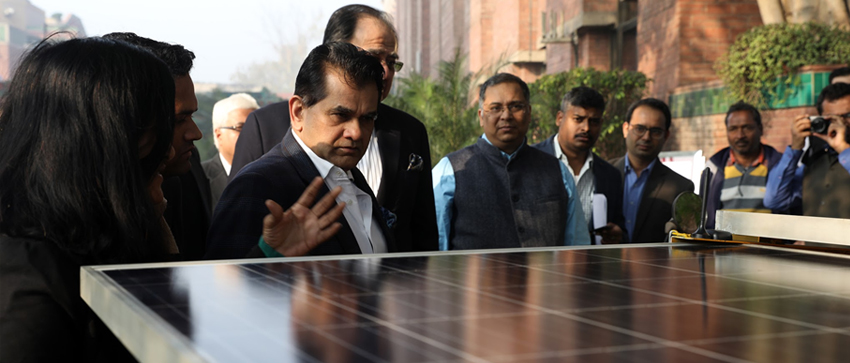Suggested Citation: Jain, Abhishek and Tauseef Shahidi. 2018. Adopting Solar for Irrigation: Farmers' Perspectives from Uttar Pradesh. New Delhi: Council on Energy, Environment and Water.
Overview
One of the biggest bottlenecks in increasing agricultural productivity in India is the lack of reliable access to irrigation. In recent years, solar pumps have emerged as an alternative to conventional pumps, filling in gaps of unreliable supply to electric pumps, and high fuel costs in running diesel pumps.
This report focuses on farmers’ awareness of solar pumps, their interest in adopting them under different deployment models, and their willingness-to-pay to own a solar pump. The report is based on a primary survey and focused group discussions, covering more than 1600 farmers in 160 villages across 10 districts of Uttar Pradesh. The following districts were a part of the survey: Bijnor, Bulandshahr, Chandauli, Chitrakoot, Gorakhpur, Kannauj, Kasganj/ Kansiram Nagar, Lalitpur, Shahjahanpur, and Sitapur. Till January 2018, over 10,000 solar pumps had been deployed across the state.

Our researchers on the ground (Source: CEEW)
The report was released by Mr Amitabh Kant, CEO, NITI Aayog, during the National Dialogue on ‘Solar for Irrigation in India’ organised by CEEW, the Shakti Sustainable Energy Foundation, and the Swiss Agency for Development and Cooperation on 18 January 2018.

Mr Amitabh Kant looks at a mobile solar pump installation at the National Dialogue on ‘Solar for Irrigation in India’ (Source: CEEW)
Key Findings
- Fifty-five per cent of the farmers surveyed mention insufficient irrigation as the biggest bottleneck to increasing incomes from farming. Moreover, 30 per cent of the farmers also reported limited water availability for irrigation as a challenge.
- Sixty per cent of marginal farmers depend on buying water, the costliest option for irrigation, or renting pumps to meet their needs.
- While 86 per cent of farmers reported having irrigation access on all sections of their land, only 51 per cent of them were satisfied with their current irrigation situation. Depleting water tables, and high expenditures on diesel were two major reasons behind farmers’ dissatisfaction.
- Only 27 per cent of farmers have heard of Solar-powered Irrigation Systems (SPIS), 14 per cent of them have seen solar pumps in reality or on television, and only two per cent of them have heard about the government schemes on solar pumps.
- About 41 per cent of farmers were interested in adopting solar pumps. Zero operational cost and convenience of use were the main reasons behind farmers’ interest in adopting solar pumps. Whereas, high capital cost was the main reason behind those not interested in adopting one.
No operational cost and convenience of use of solar pumps encourage its adoption

Source: Authors’ analysis
Key Recommendations
- Focus on awareness generation and technology demonstration is crucial. Deploy at least five solar pumps in each block of the country, prioritising regions with better groundwater availability, to enable demonstration effect to yield bottom-up demand.
- Improve targeting of prevailing government support schemes on solar pumps. Focus on marginal farmers by promoting smaller (sub-HP to 3HP) solar pumps through capital subsidy. For larger pumps, focus on strengthening the financial ecosystem rather than offering capital subsidy support, which mainly benefits medium and large farmers.
- Encourage innovative deployment approaches such as solar-powered water-as-a-service model, and the joint-ownership model to cater to marginal farmers, who otherwise are not interested to own solar pumps due to high upfront cost, and limited irrigation needs.
- Develop financial products suitable for farmers’ needs. Banks and financial institutions to simplify and standardise processes, and provide proactive support to avoid customer harassment during loan applications.
- Consider the pattern of borewell ownership while framing policies supporting solar pumps, otherwise the targeting of policy support could remain significantly skewed towards medium and large farmers.
A customer-centric approach coupled with greater focus on marginal farmers is crucial to scaling-up solar-powered irrigation systems in Uttar Pradesh.







